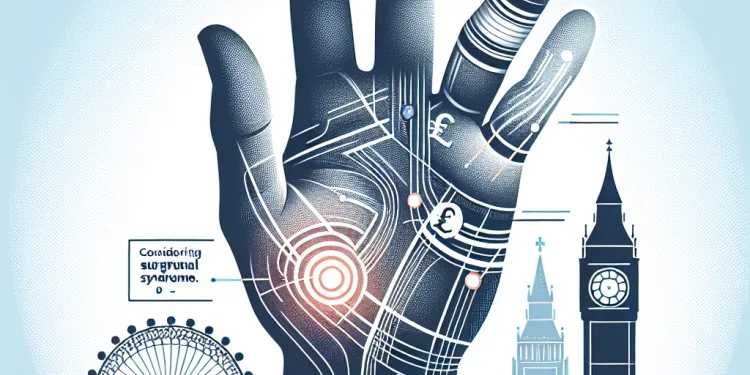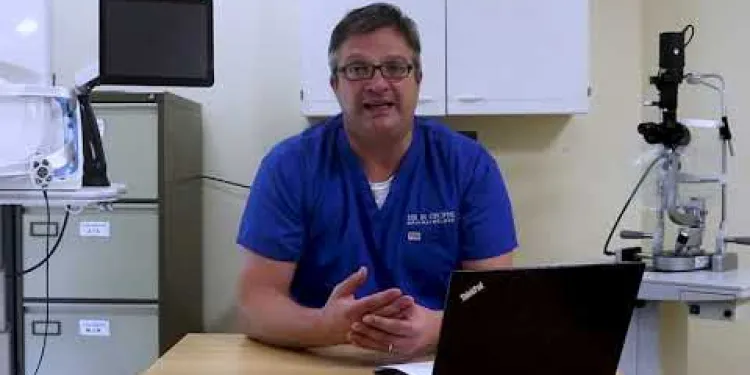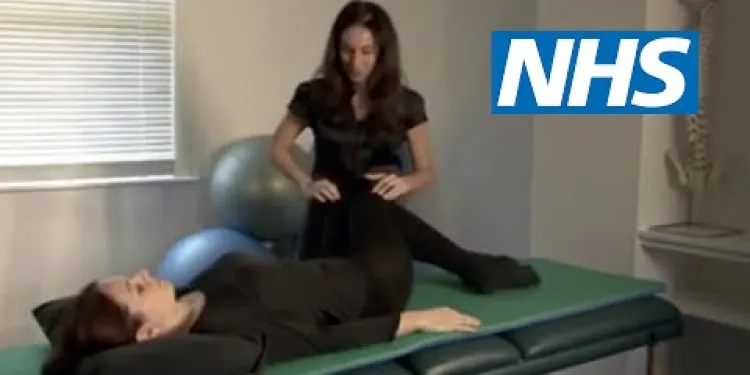
Find Help
More Items From Ergsy search
-

How is Carpal Tunnel Syndrome diagnosed?
Relevance: 100%
-

Carpal Tunnel Syndrome
Relevance: 90%
-

Is Carpal Tunnel Syndrome covered by the NHS?
Relevance: 89%
-

What is Carpal Tunnel Syndrome (CTS)?
Relevance: 86%
-

What causes Carpal Tunnel Syndrome?
Relevance: 85%
-

How can I prevent Carpal Tunnel Syndrome?
Relevance: 81%
-

When should I consider surgery for Carpal Tunnel Syndrome?
Relevance: 80%
-

Are there any alternative treatments for Carpal Tunnel Syndrome?
Relevance: 78%
-

Can Carpal Tunnel Syndrome recur after treatment?
Relevance: 77%
-

What non-surgical treatments are available for Carpal Tunnel Syndrome?
Relevance: 77%
-

Are there specific exercises that can help with Carpal Tunnel Syndrome?
Relevance: 77%
-

What does Carpal Tunnel Syndrome surgery involve?
Relevance: 76%
-

What are the common symptoms of Carpal Tunnel Syndrome?
Relevance: 70%
-

Can I work or continue sports activities if I have Carpal Tunnel Syndrome?
Relevance: 69%
-

Can lifestyle changes help manage Carpal Tunnel Syndrome?
Relevance: 68%
-

What is the recovery time after Carpal Tunnel Surgery?
Relevance: 57%
-

Diagnosing irritable bowel syndrome (IBS)
Relevance: 35%
-

How is chronic fatigue syndrome diagnosed?
Relevance: 29%
-

What is Cushing's syndrome?
Relevance: 26%
-

Munchausen's syndrome | NHS
Relevance: 26%
-

Having a child with Down's syndrome | NHS
Relevance: 26%
-

What is the difference between autism and Asperger's syndrome?
Relevance: 25%
-

Turner syndrome: Beyond the classic XO phenotype
Relevance: 25%
-

What is complex sleep apnea syndrome?
Relevance: 25%
-

Charles Bonnet Syndrome
Relevance: 25%
-

Prader-Willi Syndrome | NHS
Relevance: 25%
-

What is chronic fatigue syndrome?
Relevance: 25%
-

Having a child with Edwards' syndrome (trisomy 18) | NHS
Relevance: 24%
-

What is congenital rubella syndrome?
Relevance: 24%
-

Down's syndrome: Emily's story | NHS
Relevance: 23%
-

Is chronic fatigue syndrome a mental illness?
Relevance: 23%
-

Is chronic fatigue syndrome contagious?
Relevance: 23%
-

Exercises for sciatica: piriformis syndrome | NHS
Relevance: 22%
-

Can children develop chronic fatigue syndrome?
Relevance: 22%
-

What causes chronic fatigue syndrome?
Relevance: 22%
-

Greater trochanteric pain syndrome
Relevance: 22%
-

What is irritable bowel syndrome (IBS)?
Relevance: 22%
-

About irritable bowel syndrome (IBS)
Relevance: 22%
-

Myalgic encephalomyelitis or chronic fatigue syndrome (ME/CFS) | NHS
Relevance: 22%
-

Who is at risk of developing chronic fatigue syndrome?
Relevance: 21%
Introduction to Carpal Tunnel Syndrome
Carpal Tunnel Syndrome (CTS) is a medical condition characterized by numbness, tingling, and weakness in the hand and arm. It occurs when the median nerve, which runs through the carpal tunnel in the wrist, becomes compressed. Proper diagnosis is essential for effective treatment. In the UK, healthcare professionals rely on a combination of medical history, physical examination, and diagnostic tests to diagnose CTS.
Medical History Evaluation
The diagnostic process for Carpal Tunnel Syndrome often begins with a thorough medical history evaluation. Patients are asked about their symptoms, including their onset, duration, and any factors that exacerbate or alleviate them. Doctors also inquire about any previous wrist injuries, medical conditions such as diabetes, and repetitive hand activities that might contribute to nerve compression. Understanding the patient's history helps the doctor determine if CTS or another condition is responsible for the symptoms.
Physical Examination
A physical examination is a crucial step in diagnosing Carpal Tunnel Syndrome. Doctors perform specific tests to assess the functionality of the median nerve. Two commonly used tests are Tinel's sign and Phalen's maneuver. In Tinel's sign, the doctor lightly taps over the median nerve at the wrist to elicit a tingling sensation in the fingers. Phalen's maneuver involves bending the wrist forward for about a minute to see if it provokes tingling or numbness. These tests help indicate the likelihood of CTS.
Electromyography and Nerve Conduction Studies
For a more definitive diagnosis of Carpal Tunnel Syndrome, doctors often recommend electrophysiological studies, such as electromyography (EMG) and nerve conduction studies (NCS). EMG measures the electrical activity of muscles at rest and during contraction. NCS assess the conduction speed of electrical impulses through the median nerve. These tests can confirm nerve compression and rule out other conditions, such as a pinched nerve in the neck, that might cause similar symptoms.
Ultrasound and MRI Imaging
In certain cases, imaging tests like ultrasound or MRI (magnetic resonance imaging) may be used to visualize the structure of the carpal tunnel and the surrounding tissues. Ultrasound can detect abnormalities in the size of the median nerve, while MRI provides detailed images of the wrist's internal structures. These imaging techniques can help identify other causes of wrist pain and ensure a comprehensive diagnosis.
Conclusion
Diagnosing Carpal Tunnel Syndrome in the UK involves a combination of patient history, physical examination, and specialized tests. Medical professionals use these methods to accurately identify CTS and differentiate it from other conditions with similar symptoms. Early diagnosis and treatment are crucial to prevent further nerve damage and to improve the quality of life for those affected by this condition.
Frequently Asked Questions
What is the first step in diagnosing Carpal Tunnel Syndrome?
The first step is typically a medical history evaluation and physical examination by a healthcare professional.
Which specific test is commonly used to diagnose Carpal Tunnel Syndrome?
Nerve conduction studies are commonly used to diagnose Carpal Tunnel Syndrome.
How does a doctor perform a nerve conduction study?
A doctor places electrodes on the skin to measure how quickly electrical signals move through the median nerve.
Can ultrasound be used in diagnosing Carpal Tunnel Syndrome?
Yes, ultrasound can be used to visualize abnormalities in the median nerve and surrounding structures.
What role does electromyography (EMG) play in diagnosis?
EMG assesses the electrical activity of muscles to detect nerve damage.
What is the purpose of a physical examination for Carpal Tunnel Syndrome?
A physical examination helps to identify symptoms like numbness, tingling, and muscle strength in the hand.
What are Tinel's and Phalen's tests?
They are clinical tests performed during a physical exam to provoke symptoms of Carpal Tunnel Syndrome.
How is Tinel's sign tested?
By tapping over the median nerve at the wrist to see if it causes tingling in the hand.
How does Phalen's test work?
The patient flexes their wrist for about 60 seconds to see if symptoms are triggered.
Why is a detailed medical history important in diagnosing Carpal Tunnel Syndrome?
It helps to identify risk factors and symptoms that are consistent with Carpal Tunnel Syndrome.
Can MRI be used to diagnose Carpal Tunnel Syndrome?
MRI is not commonly used but may be employed in complex cases to visualize soft tissues.
Is a blood test required to diagnose Carpal Tunnel Syndrome?
Blood tests are not required to diagnose but may be used to rule out other conditions like diabetes or rheumatoid arthritis.
How important is symptom monitoring in diagnosis?
Symptom monitoring helps the doctor confirm the presence and progression of Carpal Tunnel Syndrome.
Can Carpal Tunnel Syndrome symptoms be self-diagnosed?
While symptoms can be noticed by the individual, a professional diagnosis is needed to confirm Carpal Tunnel Syndrome.
Why might a doctor perform a grip strength test?
To assess weakness in hand muscles, which can indicate Carpal Tunnel Syndrome.
Can family history play a role in diagnosis?
Yes, family history may suggest a genetic predisposition to Carpal Tunnel Syndrome.
What is the role of patient questionnaires in diagnosis?
They can help document the severity and frequency of symptoms.
How long does the diagnostic process typically take?
The process can vary but generally includes an initial evaluation followed by specific tests if needed.
Is it necessary to see a specialist for diagnosis?
A primary care doctor can often diagnose Carpal Tunnel Syndrome, but a specialist may be consulted for further evaluation or treatment.
What other conditions can mimic Carpal Tunnel Syndrome symptoms?
Conditions such as arthritis, tendonitis, and nerve impingement can mimic Carpal Tunnel Syndrome symptoms and should be ruled out.
Useful Links
- Ergsy carfully checks the information in the videos we provide here.
- Videos shown by Youtube after a video has completed, have NOT been reviewed by ERGSY.
- To view, click the arrow in centre of video.
- Most of the videos you find here will have subtitles and/or closed captions available.
- You may need to turn these on, and choose your preferred language.
- Go to the video you'd like to watch.
- If closed captions (CC) are available, settings will be visible on the bottom right of the video player.
- To turn on Captions, click settings .
- To turn off Captions, click settings again.
More Items From Ergsy search
-

How is Carpal Tunnel Syndrome diagnosed?
Relevance: 100%
-

Carpal Tunnel Syndrome
Relevance: 90%
-

Is Carpal Tunnel Syndrome covered by the NHS?
Relevance: 89%
-

What is Carpal Tunnel Syndrome (CTS)?
Relevance: 86%
-

What causes Carpal Tunnel Syndrome?
Relevance: 85%
-

How can I prevent Carpal Tunnel Syndrome?
Relevance: 81%
-

When should I consider surgery for Carpal Tunnel Syndrome?
Relevance: 80%
-

Are there any alternative treatments for Carpal Tunnel Syndrome?
Relevance: 78%
-

Can Carpal Tunnel Syndrome recur after treatment?
Relevance: 77%
-

What non-surgical treatments are available for Carpal Tunnel Syndrome?
Relevance: 77%
-

Are there specific exercises that can help with Carpal Tunnel Syndrome?
Relevance: 77%
-

What does Carpal Tunnel Syndrome surgery involve?
Relevance: 76%
-

What are the common symptoms of Carpal Tunnel Syndrome?
Relevance: 70%
-

Can I work or continue sports activities if I have Carpal Tunnel Syndrome?
Relevance: 69%
-

Can lifestyle changes help manage Carpal Tunnel Syndrome?
Relevance: 68%
-

What is the recovery time after Carpal Tunnel Surgery?
Relevance: 57%
-

Diagnosing irritable bowel syndrome (IBS)
Relevance: 35%
-

How is chronic fatigue syndrome diagnosed?
Relevance: 29%
-

What is Cushing's syndrome?
Relevance: 26%
-

Munchausen's syndrome | NHS
Relevance: 26%
-

Having a child with Down's syndrome | NHS
Relevance: 26%
-

What is the difference between autism and Asperger's syndrome?
Relevance: 25%
-

Turner syndrome: Beyond the classic XO phenotype
Relevance: 25%
-

What is complex sleep apnea syndrome?
Relevance: 25%
-

Charles Bonnet Syndrome
Relevance: 25%
-

Prader-Willi Syndrome | NHS
Relevance: 25%
-

What is chronic fatigue syndrome?
Relevance: 25%
-

Having a child with Edwards' syndrome (trisomy 18) | NHS
Relevance: 24%
-

What is congenital rubella syndrome?
Relevance: 24%
-

Down's syndrome: Emily's story | NHS
Relevance: 23%
-

Is chronic fatigue syndrome a mental illness?
Relevance: 23%
-

Is chronic fatigue syndrome contagious?
Relevance: 23%
-

Exercises for sciatica: piriformis syndrome | NHS
Relevance: 22%
-

Can children develop chronic fatigue syndrome?
Relevance: 22%
-

What causes chronic fatigue syndrome?
Relevance: 22%
-

Greater trochanteric pain syndrome
Relevance: 22%
-

What is irritable bowel syndrome (IBS)?
Relevance: 22%
-

About irritable bowel syndrome (IBS)
Relevance: 22%
-

Myalgic encephalomyelitis or chronic fatigue syndrome (ME/CFS) | NHS
Relevance: 22%
-

Who is at risk of developing chronic fatigue syndrome?
Relevance: 21%


